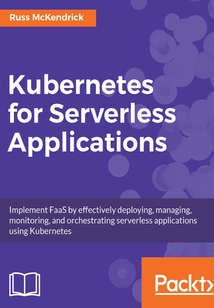舉報(bào) 

會員
Kubernetes for Serverless Applications
IfyouareaDevOpsengineer,cloudarchitect,orastakeholderkeentolearnaboutserverlessfunctionsinKubernetesenvironments,thenthisbookisforyou.
目錄(220章)
倒序
- 封面
- 版權(quán)信息
- Packt Upsell
- Why subscribe?
- PacktPub.com
- Contributors
- About the author
- About the reviewer
- Packt is searching for authors like you
- Preface
- Who this book is for
- What this book covers
- To get the most out of this book
- Download the example code files
- Download the color images
- Conventions used
- Get in touch
- Reviews
- The Serverless Landscape
- Serverless and Functions as a Service
- Pets cattle chickens insects and snowflakes
- Pets
- Cattle
- Chickens
- Insects
- Snowflakes
- Summing up
- Serverless and insects
- Public cloud offerings
- AWS Lambda
- Prerequisites
- Creating a Lambda function
- Microsoft Azure Functions
- Prerequisites
- Creating a Function app
- The serverless toolkit
- Problems solved by serverless and Functions as a Service
- Summary
- An Introduction to Kubernetes
- A brief history of Kubernetes
- Control groups
- lmctfy
- Borg
- Project Seven
- An overview of Kubernetes
- Components
- Pods and services
- Workloads
- ReplicaSet
- Deployments
- StatefulSets
- Kubernetes use cases
- References
- Summary
- Installing Kubernetes Locally
- About Minikube
- Installing Minikube
- macOS 10.13 High Sierra
- Windows 10 Professional
- Ubuntu 17.04
- Hypervisors
- Starting Minikube
- Minikube commands
- Stop and delete
- Environment
- Virtual machine access and logs
- Hello world
- The dashboard
- The command line
- References
- Summary
- Introducing Kubeless Functioning
- Installing Kubeless
- The Kubeless Kubernetes cluster
- The command-line client
- macOS 10.13 High Sierra
- Windows 10 Professional
- Ubuntu 17.04
- The Kubeless web interface
- Kubeless overview
- So what is Kubeless?
- Who made Kubeless?
- Kubeless commands
- Hello world
- The basic example
- An example of reading data
- Twitter example
- The Twitter API
- Adding secrets to Kubernetes
- The Twitter function
- The Kubeless serverless plugin
- Summary
- Using Funktion for Serverless Applications
- Introducing Funktion
- Installing and configuring Funktion
- The command-line client
- macOS 10.13 High Sierra
- Windows 10 Professional
- Ubuntu 17.04
- Launching a single-node Kubernetes cluster
- Bootstrapping Funktion
- Deploying a simple function
- Twitter streams
- Summary
- Installing Kubernetes in the Cloud
- Launching Kubernetes in DigitalOcean
- Creating Droplets
- Deploying Kubernetes using kubeadm
- Removing the cluster
- Launching Kubernetes in AWS
- Getting set up
- Launching the cluster using kube-aws
- The Sock Shop
- Removing the cluster
- Launching Kubernetes in Microsoft Azure
- Preparing the Azure command-line tools
- Launching the AKS cluster
- The Sock Shop
- Removing the cluster
- Launching Kubernetes on the Google Cloud Platform
- Installing the command-line tools
- Launching the Google container cluster
- The Sock Shop
- Running Kubeless
- Removing the cluster
- Summary
- Apache OpenWhisk and Kubernetes
- Apache OpenWhisk overview
- Running Apache OpenWhisk locally
- Installing Vagrant
- Downloading and configuring Apache OpenWhisk
- Installing the Apache OpenWhisk client
- Hello world
- Running Apache OpenWhisk on Kubernetes
- Deploying OpenWhisk
- CouchDB
- Redis
- API Gateway
- ZooKeeper
- Kafka
- Controller
- Invoker
- NGINX
- Configuring OpenWhisk
- Hello world
- Summary
- Launching Applications Using Fission
- Fission overview
- Installing the prerequisites
- Installing Helm
- Installing the Fission CLI
- Running Fission locally
- Launching Fission using Helm
- Working through the output
- Launching our first function
- A guestbook
- Fission commands
- The fission function command
- The create command
- The get option
- The list and getmeta commands
- The logs command
- The update command
- The delete command
- The fission environment command
- The create command
- The list and get command
- The delete command
- Running Fission in the cloud
- Launching the Kubernetes cluster
- Installing Fission
- The guestbook
- Some more examples
- Weather
- Slack
- Whales
- Summary
- Looking at OpenFaaS
- An introduction to OpenFaaS
- Running OpenFaaS locally
- The OpenFaaS command-line client
- Docker
- Starting the Minikube cluster
- Installing OpenFaaS using Helm
- Hello world!
- The OpenFaaS UI and store
- Prometheus
- Summary
- Serverless Considerations
- Security best practices
- Securing Kubernetes
- Securing serverless services
- OpenFaaS
- Kubeless
- Funktion
- Apache OpenWhisk
- Fission
- Conclusions
- Monitoring Kubernetes
- The dashboard
- Google Cloud
- Microsoft Azure
- Summary
- Running Serverless Workloads
- Evolving software and platforms
- Kubernetes
- Serverless tools
- Kubeless
- Apache OpenWhisk
- Fission
- OpenFaaS
- Funktion
- Future developments
- Why Functions as a Service on Kubernetes
- Fixed points
- Databases
- Storage
- Summary
- Other Books You May Enjoy
- Leave a review - let other readers know what you think 更新時(shí)間:2021-07-02 19:17:28
推薦閱讀
- 智能傳感器技術(shù)與應(yīng)用
- OpenStack for Architects
- ETL with Azure Cookbook
- 控制與決策系統(tǒng)仿真
- JBoss ESB Beginner’s Guide
- PostgreSQL Administration Essentials
- Docker Quick Start Guide
- 運(yùn)動控制器與交流伺服系統(tǒng)的調(diào)試和應(yīng)用
- Cloudera Administration Handbook
- Implementing Splunk 7(Third Edition)
- 人工智能實(shí)踐錄
- Blender 3D Printing by Example
- Excel 2007技巧大全
- 基于神經(jīng)網(wǎng)絡(luò)的監(jiān)督和半監(jiān)督學(xué)習(xí)方法與遙感圖像智能解譯
- 在實(shí)戰(zhàn)中成長:C++開發(fā)之路
- 基于Proteus的PIC單片機(jī)C語言程序設(shè)計(jì)與仿真
- Red Hat Enterprise Linux 5.0服務(wù)器構(gòu)建與故障排除
- 基于元胞自動機(jī)的人群疏散系統(tǒng)建模與分析
- 深度學(xué)習(xí)500問:AI工程師面試寶典
- Adobe Edge Quickstart Guide
- Machine Learning with R Quick Start Guide
- INSTANT Oracle GoldenGate
- 操作系統(tǒng)及網(wǎng)絡(luò)應(yīng)用技術(shù)
- 物聯(lián)網(wǎng)應(yīng)用與解決方案
- Deep Learning with PyTorch 1.x
- OpenGL 4 Shading Language Cookbook(Second Edition)
- 人人都應(yīng)該知道的人工智能
- 無線傳感器網(wǎng)絡(luò)信息處理與組網(wǎng)設(shè)計(jì)
- Word 2003中文字處理考前12小時(shí)
- 數(shù)據(jù)挖掘與機(jī)器學(xué)習(xí)

